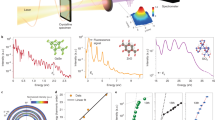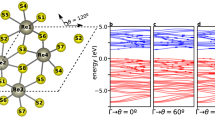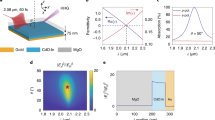Abstract
When intense light interacts with an atomic gas, recollision between an ionizing electron and its parent ion1 creates high-order harmonics of the fundamental laser frequency2. This sub-cycle effect generates coherent soft X-rays3 and attosecond pulses4, and provides a means to image molecular orbitals5. Recently, high harmonics have been generated from bulk crystals6,7, but what mechanism8,9,10,11,12 dominates the emission remains uncertain. To resolve this issue, we adapt measurement methods from gas-phase research13,14 to solid zinc oxide driven by mid-infrared laser fields of 0.25 volts per ångström. We find that when we alter the generation process with a second-harmonic beam, the modified harmonic spectrum bears the signature of a generalized recollision between an electron and its associated hole11. In addition, we find that solid-state high harmonics are perturbed by fields so weak that they are present in conventional electronic circuits, thus opening a route to integrate electronics with attosecond and high-harmonic technology. Future experiments will permit the band structure of a solid15 to be tomographically reconstructed.
This is a preview of subscription content, access via your institution
Access options
Subscribe to this journal
Receive 51 print issues and online access
$199.00 per year
only $3.90 per issue
Buy this article
- Purchase on Springer Link
- Instant access to full article PDF
Prices may be subject to local taxes which are calculated during checkout



Similar content being viewed by others
Change history
07 December 2016
A Correction to this paper has been published: https://doi.org/10.1038/nature20809
References
Corkum, P. B. A plasma perspective on strong field multiphoton ionization. Phys. Rev. Lett. 71, 1994–1997 (1993)
L’Huillier, A. & Balcou, P. High-order harmonic generation in rare gases with a 1-ps 1053-nm laser. Phys. Rev. Lett. 70, 774–777 (1993)
Spielmann, Ch et al. Generation of coherent soft X-rays in the water window using 5-femtosecond laser pulses. Science 278, 661–664 (1997)
Goulielmakis, E. et al. Single-cycle nonlinear optics. Science 320, 1614–1617 (2008)
Itatani, J. et al. Tomographic imaging of molecular orbitals. Nature 432, 867–871 (2004)
Ghimire, S. et al. Observation of high-order harmonic generation in a bulk crystal. Nature Phys. 7, 138–141 (2011)
Schubert, O. et al. Sub-cycle control of terahertz high-harmonic generation by dynamical Bloch oscillations. Nature Photon. 8, 119–123 (2014)
Kemper, F., Moritz, B., Freericks, J. K. & Devereaux, T. P. Theoretical description of high-order harmonic generation in solids. New J. Phys. 15, 023003 (2013)
Higuchi, T., Stockman, M. I. & Hommelhoff, P. Strong-field perspective on high-harmonic radiation from bulk solids. Phys. Rev. Lett. 113, 213901 (2014)
Golde, D., Meier, T. & Koch, S. High harmonics generated in semiconductor nanostructures by the coupled dynamics of optical inter- and intraband excitations. Phys. Rev. B 77, 075330 (2008)
Vampa, G. et al. Theoretical analysis of high harmonic generation in solids. Phys. Rev. Lett. 113, 073901 (2014)
Hawkins, P. G., Ivanov, M. Y. & Yakovlev, V. S. Effect of multiple conduction bands on high-harmonic emission from dielectrics. Phys. Rev. A 91, 013405 (2015)
Dudovich, N. et al. Measuring and controlling the birth of attosecond XUV pulses. Nature Phys. 2, 781–786 (2006)
He, X. et al. Interference effects in two-color high-order harmonic generation. Phys. Rev. A 82, 033410 (2010)
Ulstrup, S. et al. Ultrafast dynamics of massive Dirac fermions in bilayer graphene. Phys. Rev. Lett. 112, 257401 (2014)
Keldysh, L. Ionization in the field of a strong electromagnetic wave. Sov. Phys. JETP 20, 1307–1314 (1965)
Stuart, B. C. et al. Nanosecond-to-femtosecond laser-induced breakdown in dielectrics. Phys. Rev. B 53, 1749–1761 (1996)
Wörner, H. J., Bertrand, J. B., Kartashov, D. V., Corkum, P. B. & Villeneuve, D. M. Following a chemical reaction using high-harmonic interferometry. Nature 466, 604–607 (2010)
Smirnova, O. et al. High harmonics interferometry of multi-electron dynamics in molecules. Nature 460, 972–977 (2009)
Zaks, B., Liu, R. B. & Sherwin, M. S. Experimental observation of electron–hole recollisions. Nature 483, 580–583 (2012)
Brunel, F. Harmonic generation due to plasma effects in a gas undergoing multiphoton ionization in the high-intensity limit. J. Opt. Soc. Am. B 7, 521–526 (1990)
Schultze, M. et al. Attosecond band-gap dynamics of silicon. Science 346, 1348–1352 (2014)
Schultze, M. et al. Controlling dielectric with the electric field of light. Nature 493, 75–78 (2012)
Vu, Q. T. et al. Light-induced gaps in semiconductor band-to-band transitions. Phys. Rev. Lett. 92, 217403 (2004)
Eremets, M. I. & Troyan, I. A. Conductive dense hydrogen. Nature Mater. 10, 927–931 (2011)
Shafir, D. et al. Resolving the time when an electron exits a tunnelling barrier. Nature 485, 343–346 (2012)
Gertsvolf, M., Spanner, M., Rayner, D. M. & Corkum, P. B. Demonstration of attosecond ionization dynamics inside transparent solids. J. Phys. At. Mol. Opt. Phys. 43, 131002 (2010)
Schiffrin, A. et al. Optical-field induced currents in dielectrics. Nature 493, 70–74 (2013)
Schwierz, F. Graphene transistors. Nature Nanotechnol. 5, 487–496 (2010)
Krausz, F. & Stockman, M. I. Attosecond metrology: from electron capture to future signal processing. Nature Photon. 8, 205–213 (2014)
Golde, D., Kira, M., Meier, T. & Koch, S. W. Microscopic theory of the extremely nonlinear terahertz response of semiconductors. Phys. Status Solidi B 248, 863–866 (2011)
Vampa, G., McDonald, C. R., Orlando, G., Corkum, P. B. & Brabec, T. Semiclassical analysis of high harmonic generation in bulk crystals. Phys. Rev. B 91, 064302 (2015)
Niikura, H. et al. Probing molecular dynamics with attosecond resolution using correlated wave packet pairs. Nature 421, 826–829 (2003)
Acknowledgements
We thank A. Larameé from the Advanced Laser Light Source for technical support during the experiment and M. Clerici for lending some equipment. We acknowledge financial support from the US AFOSR, NSERC, FRQNT, MDEIE and CFI.
Author information
Authors and Affiliations
Contributions
G.V. and P.B.C. conceived the experiment; G.V., T.J.H. and N.T. performed the experiment; N.T. and B.E.S. developed the laser source; P.B.C. and F.L. supervised the experiment; C.R.M. and T.B. supervised the theoretical calculations; all authors contributed to the manuscript.
Corresponding authors
Ethics declarations
Competing interests
The authors declare no competing financial interests.
Extended data figures and tables
Extended Data Figure 1 Evolution of conduction band population with time as a function of Bloch vector.
Population in the conduction band (colour-coded, key at right) is created at each peak of the laser field and subsequently accelerated to large crystal momenta. The population is resolved along the ΓM direction of the Brillouin zone.
Extended Data Figure 2 High-harmonic emission is timed to the electron–hole recollision.
The spectral content of the intraband (a) and interband (b) mechanisms as a function of time shows that each high harmonic is emitted at a specific moment of the laser cycle. This moment is the time of generalized recollision between the electron and the hole (red line). The intensity (colour-coded) is on a logarithmic scale. The laser parameters are: ω = 0.0121 a.u., F0 = 0.0049 a.u.
Extended Data Figure 3 Predicted in situ spectrograms.
Simulated spectrogram for interband (a) and intraband (b) emission. Intensity is colour-coded on a logarithmic scale. Each harmonic order has been normalized to simplify comparison. The laser parameters are: ω = 0.0121 a.u., F0 = 0.0049 a.u., F2ω = 10−2 F0.
Extended Data Figure 4 Comparison of atomic and solid high-harmonic generation.
The phase of the modulation of the even harmonic intensity is plotted as a function of harmonic order. The green line is obtained for an atom with ionization potential equal to the bandgap of ZnO (3.3 eV, marked by the vertical black dashed line). The blue line and the black circles are the theoretical prediction for the interband source and the experimental data points, respectively. The theoretical prediction is based on classical trajectory calculation.
Extended Data Figure 5 Cut-off scaling of interband emission.
The high-harmonic cut-off of interband emission predicted by the numerical solution of the two-band model is plotted as a function of field strength. The cut-off scales linearly with the field strength up to the maximum bandgap (reached at the edge of the Brillouin zone). The calculated values (red dots) are connected by the dashed dotted line to show the linear scaling.
Extended Data Figure 6 Scaling of high-harmonic emission with the field strength of the fundamental.
The two-band model predicts that interband emission dominates over a wide range of field strengths. The field strength of our experiment is F0 = 0.0049 a.u. (middle panel), while that of ref. 6 corrected for the reflection loss is F0 = 0.008 a.u. (bottom panel). The vertical black dashed line marks the minimum bandgap (at 3.3 eV).
Rights and permissions
About this article
Cite this article
Vampa, G., Hammond, T., Thiré, N. et al. Linking high harmonics from gases and solids. Nature 522, 462–464 (2015). https://doi.org/10.1038/nature14517
Received:
Accepted:
Published:
Issue Date:
DOI: https://doi.org/10.1038/nature14517
This article is cited by
-
Observation of interband Berry phase in laser-driven crystals
Nature (2024)
-
Sub-cycle multidimensional spectroscopy of strongly correlated materials
Nature Photonics (2024)
-
Build-up and dephasing of Floquet–Bloch bands on subcycle timescales
Nature (2023)
-
Lightwave electronics in condensed matter
Nature Reviews Materials (2023)
-
High-order harmonic generation from a thin film crystal perturbed by a quasi-static terahertz field
Nature Communications (2023)
Comments
By submitting a comment you agree to abide by our Terms and Community Guidelines. If you find something abusive or that does not comply with our terms or guidelines please flag it as inappropriate.



